Are you suffering from redness and swelling around your nails of late? There is a strong possibility that you are suffering from Paronychia, a common skin infection. Read on to know all about Paronychia, its causes, symptoms, diagnosis and treatment.
Paronychia Definition
Page Contents

Picture 1 – Paronychia
Source – womenfitness
Medically, Paronychia is usually defined as an inflammation of the tissue around a toenail or fingernail.
What Is Paronychia Actually?
Paronychia is a particular type of infection that affects the soft tissues in the folds of nails in the fingers or toes. A Paronychia infection of the nail fold can result in redness and inflammation in the region. It can be quite painful.
Types of Paronychia
Paronychia is of two kinds :
Acute Paronychia
It occurs in any separation in the skin. The infection begins in the soft tissues located at the sides of the nail in the toes and fingers. Paronychia of toe as well as Paronychia of finger can lead to swelling, redness and pain.
Chronic Paronychia
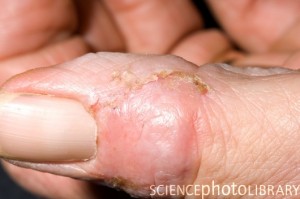
Picture 2 – Chronic Paronychia
Source – sciencephotolibrary
It mainly affects people whose hands and feet are exposed to moist surroundings. The infection also results from Contact Dermatitis.
Paronychia Pronunciation
Paronychia is pronounced as “par-o-ni-kia”.
Paronychia Symptoms
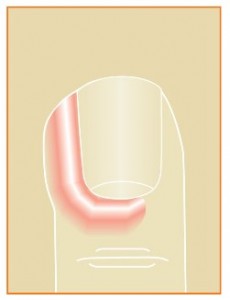
Picture 3 – Paronychia Infection
Source – sonnietrotter
Some of the main symptoms of Paronychia involve :
Redness
The area around the nail turns red in appearance and gives the fingers or toes a fearful appearance.
Swelling
The region suffers an inflammation due to a Paronychia infection. The swelling often arises at the cuticle or any other region that has recently suffered an injury.
Pain
Pain is one of the most notable symptoms of Paronychia. A person infected with Paronychia experiences pain in and around the nails.
Blisters
The infection can also give rise to pus-filled blisters in the region. In people with Paronychia drainage from blisters is common.
Changes in Nail
Infection can also lead to changes in the nail. In Paronychia finger infection nail shape and color may begin to change.
In some cases, Paronychia causes other health problems like fever, chills, joint pain and muscular ache. Red blotches may appear all over the skin. It is important to quickly get the ad of a doctor in such cases.
What Causes Paronychia?
The main causes of Paronychia involve injury to the nails or over-exposure of the nails to moist surroundings. Biting a part of the nail or a part of the skin around the nail can lead to Paronychia. Over-trimming of the nail cuticle can also result in a nail infection. Paronychia of the nail can result from a bacterial, fungal or yeast infection.
People who have diabetes can have it. In patients of Paronychia diabetes is often seen as a causative factor. People who have to work for long hours in water are also at risk from this condition. Moistening tissues around nails can invite Paronychia bacterial infection.
Paronychia Diagnosis
Diagnosis of Paronychia is mainly carried out through physical observation. An expert doctor generally detects the condition simply by looking at the affected nails.
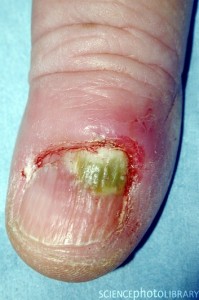
Picture 4 – Paronychia Photo
Source – sciencephoto
In some cases, the blisters may be drained and a sample of the pus sent for laboratory examination. Tests are conducted to find out the exact type of fungus or bacteria causing Paronychia.
Paronychia Treatment
For an effective cure of Paronychia antibiotic treatment is generally recommended by doctors. People with Paronychia fungal infection are generally treated with antifungal medicine. Paronychia medication is a topical antifungal medicine like Ketoconazole cream.
In severe cases where the patient experiences too much pain in the nails, the doctor may try Paronychia incision. In this Paronychia surgical treatment the sore is cut with a sharp surgical knife to drain the pus. A part of the nail may also be removed for faster Paronychia cure and better recovery.
Paronychia Home Treatment
For people with Paronychia home remedy is necessary along with professional medical care. Some of the main Paronychia remedies include
Hot water Soaks
If you have bacterial Paronychia, you may soak your nails in hot water daily for 2-3 times. Paronychia soak helps reduce pain and swelling. Hot water soaks are very effective as a Paronychia treatment at home.
Keep The Skin Dry
People having Paronychia due to prolonged exposure of nails to moist surroundings should try to keep the skin around the nails dry. You may use skin-drying substances like Castellani’s paint around the nails in fingers and toes to prevent bacterial Paronychia nail infection.
Paronychia treatment at home is highly crucial. It is important that you do not neglect it.
How Long Does Paronychia Last?
Paronychia infection generally responds quite well to treatment. Paronychia healing time is usually a few weeks. In patients of fungal infection Paronychia recovery time can be several months.
Paronychia Complications
Paronychia untreated can give rise to a number of complications like :
Abscesses
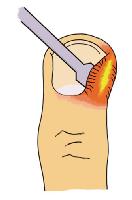
Picture 5 – Paronychia Drainage
Source – medscape
Lack of medical care can cause pus-filled vesicles around the nail in the fingers or toes. Paronychia abscesses can release viscous discharge from time to time, especially under pressure.
Alteration of Shape
There can be a permanent change in the shape of the nail. In Paronychia nails may get deformed and have an abnormal appearance.
Spread of Infection
Ignoring the infection for a long time can make it spread to other parts of the body like bones or tendons. In worse cases, it may affect the bloodstream.
Paronychia Pictures
Have any idea how Paronychia in the nails look like? Check out these Paronychia photos. These Paronychia images will help you know how nails affected by the condition look like. Know what does Paronychia look like?
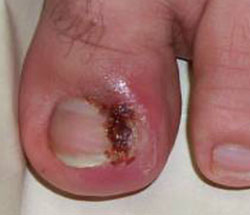
Picture 6 – Paronychia Toe
Source – health911
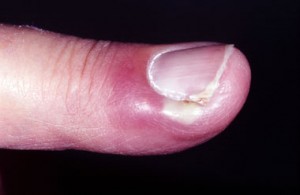
Picture 7 – Paronychia Finger
Source – skininfection
In case of Paronychia medical treatment is highly necessary. The faster you take medical assistance, the better chances you will have of making a faster recovery without forming any complications.

What type of md. Is best to see for treatment of a chronic paronychia of the finger.
I appear to have paronychia on my index finger. I have been to the Dr. twice. The 1st time he gave me doxcycline and there was no improvement. The 2nd time I was given a Z-Pack. I am on my last day and it still looks like the 1st day when i went! Is this normal?
I had a huge success on my Paronychia finger. LaST Thursday night Doc said he wanted to lance finger open on Sunday. GAve me Cephlexen which did not seem to change things. I hate stuff like getting cut upon. SO….I thunk and thunk. I raise fancy horses. A horse hoof is a middle finger fingernail after evolution. Hmmmm, it was my middle finger that got infected around the fingernail. With horses if an abscess in foot, a great treatment is to cover horse foot coronet band (like where our cuticle is) with Ichthammol Ointment ( http://herbs.lovetoknow.com/Ichthammol_Ointment ). Black, stinky, gross stuff. Then with horse, you wrap with plastic after application of Ichthammol….maybe makes it sweat. I have seen amazing things with the Ichthammol drawing deep hoof abscesses up through the coronet band. Anyhow, I did exactly the same to my finger. With two treatments I was able to drain. It was crazy stuff, and I got to call off the doctor cutting me open. Now just soaking to promote healing. I guess officially my affliction was called Paronychia. SO painful and I can take a lot of pain! Now it only hurts a lot instead of excruciating but every hour getting much better. I believe the worst is over. Thank you veterinary remedies!
it done ent from blistering to itching to eherever touch begns to itch